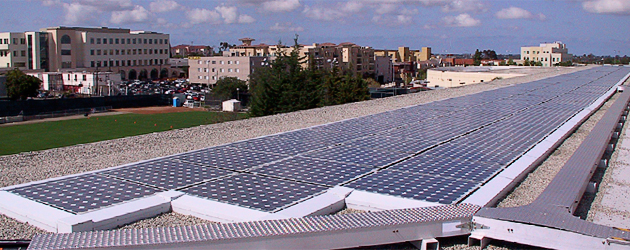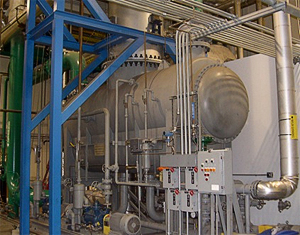Powering Through the Regional Blackout
The campus maintained critical operations thanks to the Cogeneration Plant, solar panel arrays and backup generators.

While many campus buildings were without power during the blackout that affected much of the southwestern United States last Thursday, SDSU Police, most residence halls and dining services remained operational and powered during the emergency.
SDSU was able to do this because it produces much of its own power, providing up to 99 percent of its daily needs through the Cogeneration Plant and solar panel arrays. Backup generators also provided power during the blackout. Additionally, Physical Plant employees worked around the clock to restore power to campus.
With campus closed Friday, SDSU sent at least two megawatts of power back to the grid by mid-morning, said Scott Burns, associate vice president for Business and Financial Affairs, enough to supply about 1,300 residential households. The campus has done this before, such as during the 2007 wildfires.

The SDSU Cogeneration Plant helps meet all of the campus’s energy needs.
Cogeneration Plant shuts down
According to Burns, the Cogeneration Plant temporarily shut down on Thursday for reasons similar to the San Onofre Nuclear Generating Station. Local news reports stated that the nuclear plant shut down when the eastern transmission line from Arizona tripped and caused a low voltage situation in San Diego. To protect sensitive equipment, the San Onofre Nuclear Generating System automatically shut itself down.
“Our power plant is somewhat like San Onofre,” Burns said. “When there’s a big disturbance in the system, certain generators will shut down to protect themselves and so that was part of the reason why we also lost power.”
Many in the region are interested in preventing another large blackout, either through safeguarding energy production from shutting down, as it did at San Onofre Nuclear Generating Station, but Burns isn’t worried about the Cogeneration Plant.
“I think our safeties worked as they were supposed to,” Burns said. “Again, the intent is not to provide 100 percent reliability, the intent of the plant is to provide efficiency and cost savings.”
When power was restored throughout the region Thursday night and early Friday morning, it came on in stages. This helped prevent a surge of power being drawn off of transmission lines, which could lead to equipment failure. SDSU did much the same when power was returned to all campus facilities on Friday, helping to prevent a demand surge on the Cogeneration Plant.
Trouble communicating
The communication limitations added to the impact of the blackout, as many residents were unable to access updated information without electricity. Additionally, for a time, many radio and television stations, including KPBS, were unable to broadcast updates due to a lack of power.
Phone lines were also busy at San Diego Gas & Electric, the utility provider for San Diego, with multiple customers contacting the company at the same time. This added to the lack of information available to San Diegans.
SDSU updated the home page with emergency information and sent several emergency cell phone texts to students, faculty and staff.
These texts were also sent to any parents of students, relatives of campus employees and others who had registered for campus emergency alerts. Register now to receive alerts in the event of future campus emergencies.
Campus power capabilities
Burns said the Congeneration Plant and various solar panel arrays meet nearly all of the campus’s energy needs, providing up to 99 percent of the energy used. The natural gas-burning plant and solar panels supply up to 14 megawatts of power, or enough energy for about 9,100 residential households. On average, the campus uses about 12 megawatts of power per day.
Several solar panel arrays are located across campus, including newer installations at the:
- Aztec Aquaplex
- SDSU Children’s Center
- Top floor of PS 1
Additional panels will also be included in the new Aztec Student Union, currently under construction.
In terms of efficiency, the campus has reduced its usage through different awareness programs, such as Associated Students Greenlove program, and installation of energy-efficient features in old and new buildings. Additionally, in 2008, SDSU updated the Interstate 8 sign to include LED technology, leading to significant energy and cost savings.


